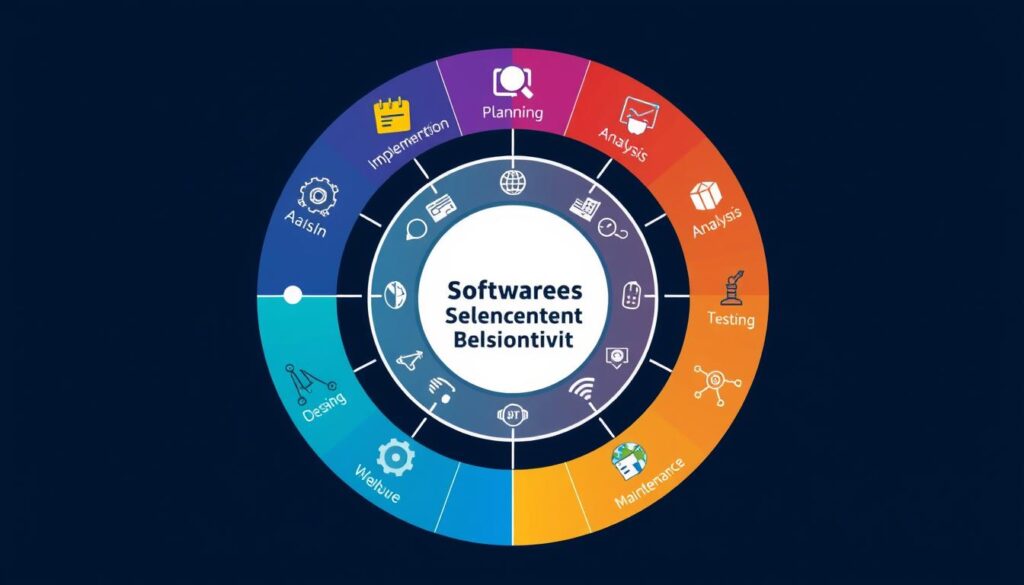The field of software development is always changing. Project management strategies help us keep up. Figures like Henry Gantt have shaped project management with tools like the Gantt chart. This tool is still used across many industries today. Achieving success in IT project management means delivering projects successfully.
Today’s project managers guide software projects through tech advances and team challenges. They use a management guide to move from ideas to fully working software. These guides help set quality standards, maintain time schedules, and manage budgets. They also show how to use Agile methods in creating digital solutions.
Software development project management includes many stages, from starting plans to final checks. The main goal is to meet stakeholder needs with quality, on budget, and on time. It’s more than just using tools; it’s about creating a space where people can work together and innovate.
Key Takeaways
- Project management is key for leading software projects from start to end, ensuring they’re finished successfully.
- About 36% of software teams use Agile principles, showing a move towards flexible project management.
- It’s important to define what a project needs to achieve to make sure it meets business goals.
- Good project planning needs teams from different areas to cover all parts of the project.
- The execution phase is crucial for making sure the final product matches the original vision.
- Reviewing projects after they’re finished helps teams improve and plan better for future projects.
- Because software development is always changing, project management needs to be flexible to each project’s needs.
Introduction to Software Development Project Management
The role of software project management is crucial in tech. It sets the path for a project’s success through organization and strategy. Software management has grown since the tech boom, adapting to the complex nature of software delivery.
Understanding Project Management Basics
Project management essentials hinge on the SDLC (Software Development Life Cycle). This guides a project from start to finish in a planned way. Whether it’s Agile, Waterfall, or a mix, SDLC models shape project management by outlining steps for achieving goals within given constraints.
Project management spans several phases: Initiation, Planning, Execution, Monitoring, and Closing. It’s more than keeping things on time. It includes leading, managing risks, and engaging with stakeholders continuously.
Importance of Effective Project Management
Good software project management aligns with business strategy and uses resources wisely. It lowers risks, reduces costs, and boosts project success. This greatly benefits an organization’s health and expansion.
Stats show that using proper project management methods can improve project success by up to 92%. This underscores the importance of skilled managers and solid project frameworks.
Here’s a closer look at management areas critical for software project success:
| Management Aspect | Description |
|---|---|
| Conflict Management | Resolving disputes and ensuring team cooperation |
| Risk Management | Identifying, analyzing, and mitigating potential risks |
| Requirement Management | Accurately capturing customer needs and ensuring they are met |
| Change Management | Adapting to changes in project scope effectively |
| Release Management | Overseeing the release process and ensuring delivery timelines are met |
Knowing these areas improves project management effectiveness. It also improves the leader’s ability to guide teams in finishing complex software projects successfully.
Key Phases of Software Development Projects
Knowing the software development lifecycle (SDLC) is key to managing projects well. The SDLC includes several steps, each designed to make software development smoother. These steps use Agile project management ideas. Agile focuses on being flexible and always getting better during the project lifecycle.
Planning Phase
The first step in the SDLC is all about detailed planning. This sets the stage for a successful project. It’s when the team decides on the project’s size, resources, timelines, and methods. This makes sure the project’s aims fit with the business goals. It also gives the team a clear plan to follow.
Execution Phase
Execution is when ideas become real software. This step includes writing the code and putting systems together. It also involves detailed checks to make sure everything matches the design and standards. Good execution requires the team to work well together. Using Agile project management helps with this teamwork.
Monitoring and Control Phase
This step is about watching the project’s progress closely. It compares what’s happening with what was planned. When things don’t go as expected, adjustments are made. This helps keep the project on track. It’s important for making sure the project is high quality and finished on time.

| SDLC Phase | Main Activities | Agile Involvement |
|---|---|---|
| Planning | Define scope, estimate timelines, allocate resources, risk management. | Early stakeholder engagement, iterative planning. |
| Execution | Development, system integration, initial testing. | Sprint cycles, daily standups. |
| Monitoring & Control | Performance tracking, quality assurance, scope verification. | Retrospectives, sprint reviews. |
It’s vital to manage the SDLC phases well for software project success. Adding Agile project management across these steps boosts flexibility and reaction speed. This is crucial in today’s quick-paced software development world.
Roles and Responsibilities in Project Management
In software development, clear roles and responsibilities are crucial. At the heart are the project management roles. These include the project manager with wide-ranging duties, the software development team, and the involved stakeholders.
Project Manager
The project manager leads, offering leadership and direction. They ensure projects are done right, on schedule, and within budget. Their tasks cover estimating costs and timing, and organizing resources and staff.
They manage risks by identifying potential problems and finding solutions. A project manager’s success depends on decisiveness, deep knowledge of methodologies, and strong communication.
Development Team
The development team moves the project forward. It includes developers, quality assurance analysts, and IT experts. They each bring vital skills to the project’s development cycle.
Their main job is to follow the project plan closely. This means coding, fixing bugs, and testing the software. They ensure the final product meets customer needs and maintains high quality.
Stakeholders
Stakeholders are clients, users, and company leaders interested in the project’s success. They play a key role in checking the project’s progress and making sure it meets business and user goals. Through regular meetings and updates, stakeholders give important feedback. This can help steer the project in the right direction, making them essential for success.
Tools and Technologies for Project Management
Using advanced project management tools makes software projects more agile and efficient. This part highlights how project management software and collaboration platforms improve workflow and team work. They are crucial in agile project management tools.
Project Management Software
Project management software is key for overseeing project aspects. It includes Gantt charts for timelines and Kanban boards for workflow visibility. Adding methods like the Critical Path Method (CPM) helps find tasks that matter most to the schedule.
Tools like the Jira software by Atlassian show how useful this tech can be. They provide templates that support agile practices, essential for current software projects.
Collaboration Tools
Software projects change a lot, requiring strong collaboration platforms. These enable instant chat, video calls, and live document work for teams worldwide. Good collaboration tools are crucial for connecting remote team members effectively.
| Feature | Benefit |
|---|---|
| Real-time updates | Keeps everyone updated instantly |
| Task Management | Tracks tasks well for individuals and teams |
| Resource Allocation | Avoids overworking and balances the team’s tasks |
| Access Control | Protects important project info by managing access rights |
| Integration Capabilities | Makes it easy to connect with other team tools |
Adopting these agile project management tools builds a transparent and accountable culture. It also makes teams more adaptable to project changes and customer needs.

Agile vs. Waterfall Methodologies
In the world of software development, choosing the right methodology is key. It deeply affects how successful your project will be. Knowing the difference between Agile and Waterfall methods is vital.
Overview of Agile Methodology
Agile focuses on flexibility and quick cycles called sprints. It boosts continual growth through steady feedback and adapts easily to new changes. Since its introduction in 2001, Agile has grown. It’s now used in many areas including IT and marketing.
Overview of Waterfall Methodology
The Waterfall method follows a step-by-step approach. Each phase must be finished before the next starts. Born in 1970, it’s a classic choice for projects that won’t really change during the process. It places a strong emphasis on sticking to the original plan.
Choosing the Right Methodology
What you pick depends on your project’s needs. Agile is great for projects that need regular updates or changes. It works well in software development and marketing. Waterfall suits projects with few changes, like in construction or manufacturing.
Modern tools can help manage projects better, no matter the methodology. For tips on great tools, visit efficient workflow management tools.
| Feature | Agile | Waterfall |
|---|---|---|
| Flexibility | High (adapts to changes) | Low (fixed project scope) |
| Feedback Incorporation | Continuous | At milestones |
| Risk Management | Continuous monitoring | Initial identification |
| Project Visibility | Better due to iterative nature | Limited to milestones |
| Best Suited for Industries | Software, Marketing | Construction, Manufacturing |
In the end, both Agile and Waterfall shine in different settings. It’s about matching the method to your project’s and organization’s needs. This choice is crucial for reaching your goals efficiently.
Risk Management in Software Projects
Effective risk management is key to successful software projects. It focuses on identifying, assessing, and reducing risks. These steps ensure the project meets its goals.
Identifying Risks
Detailed project risk analysis is crucial early in the project. It spots potential problems in areas like tech, business, and operations. This includes issues such as programming challenges and budget limits.
Technical risks may involve software glitches or compatibility issues. Business risks might include losing stakeholder support or changing market needs. And operational risks could be about not having enough resources or logistical problems. A good risk management plan tackles these issues early. This helps the project succeed in delivering quality work on time.
Mitigating Risks
Risk mitigation strategies are about handling risks found during analysis. This might mean making backup plans, moving resources to important activities, and better team communication. These steps help everyone stay ready to face risks head-on.
- Technical risks can be lowered by early prototyping and constant testing. This ensures the project works well and stays stable.
- Business risks need strong change management and keeping stakeholders involved to keep their support.
- Operational risks can be reduced with good resource management and flexible project schedules.
Using these strategies helps overcome challenges smoothly. It also lowers development costs, prevents spending too much, and improves results.
In conclusion, good risk management is vital in software development. With careful project risk analysis and risk mitigation strategies, software projects are more likely to succeed. This means finishing on time, staying within budget, and achieving high quality.
Best Practices for Successful Software Development Management
In the world of software development, moving from an idea to a final product has its challenges. Studies show that 75% of business and IT leaders expect projects might fail. Only 25% of software projects are finished successfully. This means that knowing how to manage projects well is crucial. It’s important to use the best methods in project management. This can help avoid problems, meet due dates, and keep deliveries high-quality without going over budget.
Communication Strategies
To tackle the issue of poor communication, which 59% of U.S. workers see as a big problem, we need to change how we talk in projects. Explaining the project goal clearly, making sure everyone agrees, and keeping talks open at all times is essential. This helps connect different groups and makes sure all team members know what’s happening. This way, they can do their best work.
Continuous Improvement Practices
Working on improving software projects continuously helps us adapt in this complex field. Using Agile methods and Scrum—chosen by 87% of Agile users—helps review and improve the project regularly. By always aiming to get better, as the Agile way shows with faster market times and less risk, we stay on top of what’s needed in today’s fast-changing software development world.
Lessons Learned from Past Projects
Also, history in project management teaches us important lessons. Organizations that value project management waste less money and achieve goals more smoothly. Looking back at past projects helps spot what works and what doesn’t. This strengthens the base for future projects. Using resources like the Software Development Life Cycle guide helps line up current projects with proven standards. This avoids the common issues of time and budget overruns seen with older methods like Waterfall.
FAQ
What is Software Development Project Management?
Software development project management focuses on planning, organizing, and overseeing resources and processes. It ensures the successful completion of software projects. Tasks include scheduling, managing resources, and controlling quality.
Why is effective project management crucial in software development?
Effective project management ensures software projects meet deadlines, budgets, and satisfaction goals. It tackles challenges like changing technologies and team dynamics. This alignment keeps projects in line with business strategies.
What are the key phases of a software development project?
Initially, the Planning phase defines the project’s scope and resources. Then, in the Execution phase, the actual software development occurs. Finally, the Monitoring and Control phase oversees progress and makes adjustments.
What are the roles and responsibilities of a Project Manager?
A Project Manager leads the software project, aiming for its success. They manage tasks from setting objectives, planning, to risk analysis. Communication with stakeholders and ensuring goals are met are key duties.
How does a Development Team contribute to a software project?
The Development Team, including programmers and IT specialists, turns plans into software. Their role is critical for creating the final product by following the Project Manager’s plan.
Who are considered stakeholders in a software development project?
Stakeholders in a project range from clients and investors to leadership and customers. They have a vested interest in the project’s success. Their feedback shapes the project throughout its lifecycle.
What is the significance of project management software in software development?
Project management software is vital for tracking a project’s parts. It helps with task assignments and monitoring progress. Everyone gets a clear view of status and what to do next.
How do collaboration tools enhance project management?
Collaboration tools support real-time teamwork and problem-solving. They keep everyone informed and aligned on project goals. Sharing documents and updates helps manage work across locations.
What is Agile methodology in software development?
Agile is a flexible development method that adapts to changes. It involves collaboration and produces regular deliverables. Agile focuses on customer satisfaction and continuous improvement.
How is the Waterfall methodology different from Agile?
Waterfall uses a step-by-step approach, finishing one phase before starting another. It suits projects with fixed requirements. This contrasts with Agile’s adaptability to change.
How do you choose the right project management methodology?
The choice depends on the project’s specifics, such as size, complexity, and change likelihood. Agile fits projects needing flexibility, while Waterfall suits definitive requirement projects.
What does risk management in software projects entail?
Risk management identifies and addresses potential project issues. A plan is created for minimizing risks. This ensures the project’s success by managing expected challenges.
What are some effective communication strategies in project management?
Key strategies include clear communication lines and using tools for regular updates. Transparency with reports and an open environment for feedback are crucial. Effective communication drives project success.
How can continuous improvement practices benefit software development management?
Continuous improvement looks at past performances for future enhancements. It’s about learning and applying lessons to improve project management methods. This evolves efficiency and effectiveness over time.
How can past projects influence future software development efforts?
“Lessons learned” sessions bring valuable insights from past projects to new ones. Reflecting on successes and failures shapes better processes and outcomes. This continuous learning refines methodologies.



